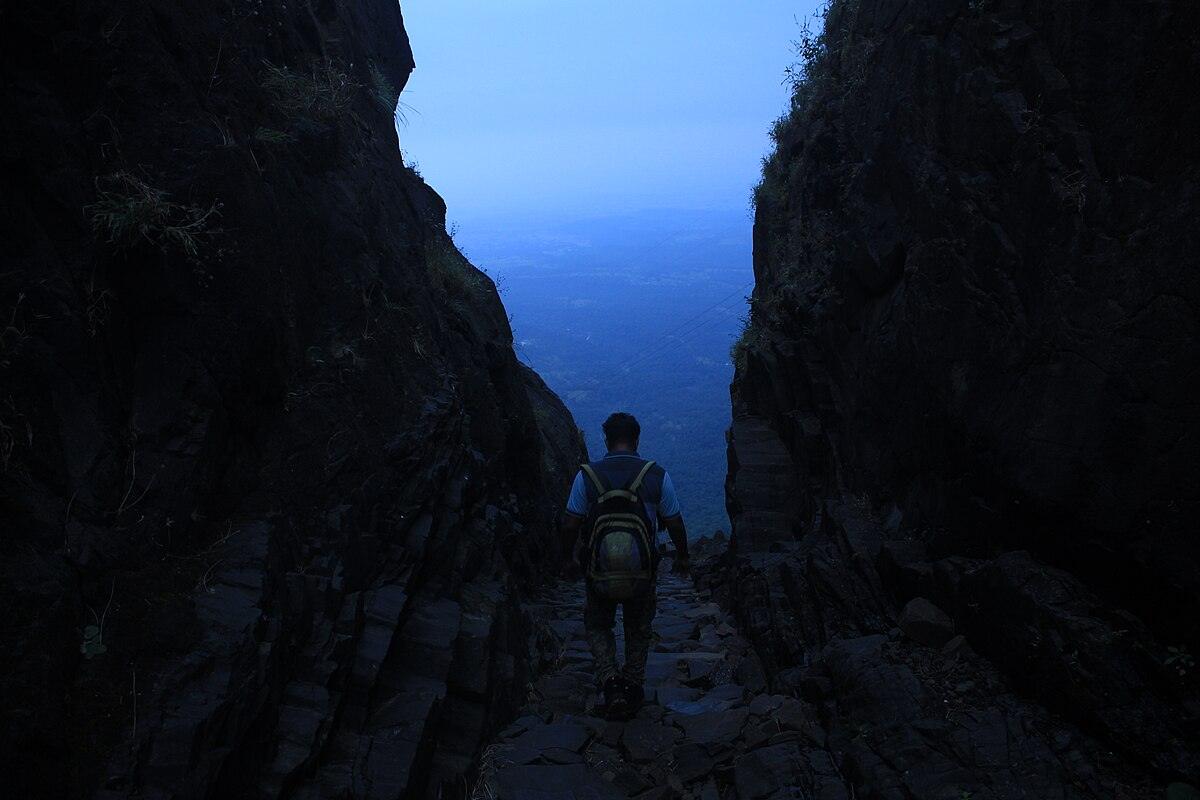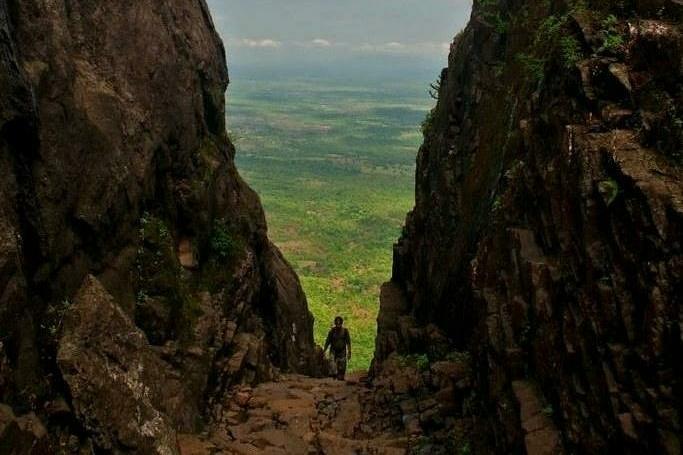Reverse Waterfall Trek: Naneghat Waterfall in India

In the heart of Maharashtra’s Western Ghats lies a surreal sight that turns the laws of nature on their head, the Naneghat Waterfall in India. Here, powerful winds during the monsoon send streams of water soaring upward, creating an optical illusion that feels almost otherworldly. For trekkers, photographers, and weekend adventurers, the Naneghat trek isn’t just about reaching a destination, it’s about witnessing one of nature’s most playful and unexpected spectacles.
This rare phenomenon, where water appears to defy gravity, offers an unforgettable escape into the lush, rain-drenched Sahyadris. It’s an experience that blends scenic drama, ancient history, and a healthy dose of thrill, making it one of Maharashtra’s most talked-about monsoon treks. For those exploring places to visit near Mumbai or searching for monsoon escapes, the Naneghat Waterfall stands out as a true gem.
In this Blog
The Historical Significance of Naneghat

Nane Ghat, which means “coin pass,” carries a legacy carved into its rocky cliffs. Once a vital trade route during the Satavahana dynasty (1st century BCE), this mountain pass connected Junnar and Kalyan, and served as a toll collection point, hence the name. Inscriptions etched into stone and age-old caves still whisper stories of merchants and dynasties long past.
Today, Naneghat Waterfall offers a rare combination, a trail that takes trekkers through history and into a natural wonder. As the climb progresses, one passes relics of a bygone era, weathered rock inscriptions, stone pillars, and cave shelters once used by traders, lending cultural depth to the wilderness adventure.
Planning the Trek
Best Time to Visit
The reverse waterfall phenomenon is best experienced during Maharashtra’s monsoon months, June to September, when the hills are lush and alive with rain-fed energy. July and August are peak months for witnessing the most spectacular displays, with water visibly being blown upwards by strong valley winds. For those who prefer slightly drier trails and gentler weather, late September to October offers a great alternative. The Naneghat Waterfall may be milder during this time, but the paths are more manageable, and the views remain undeniably rewarding.
Getting to the Adventure
Naneghat is easily accessible from both Mumbai and Pune, making it an ideal weekend escape.
From Mumbai (approx. 140 km):
- Take the Mumbai-Nashik Highway (NH 160)
- Turn off toward Malshej Ghat
- Drive time: Around 3 to 4 hours
From Pune (approx. 120 km):
- Follow the Pune-Nashik Highway
- Detour toward Malshej Ghat
- Drive time: Around 2.5 to 3 hours
If you’re calculating Mumbai to Pune distance, it’s around 150 km by road, and Naneghat lies conveniently between the two cities.
Public buses run to Malshej Ghat from both cities, though they can be less frequent during monsoons. Many trekkers opt for private cabs or join group treks organized by local adventure companies. A route map or a location map can help navigate through the winding ghats and scenic routes leading up to the trailhead.
Essential Gear
Monsoon trekking is thrilling, but it calls for some basic gear to keep things fun and safe. Essentials include:
- Waterproof backpack with a rain cover
- Fast-drying clothes and a rain poncho or jacket
- Trekking shoes with a strong grip
- Extra clothes in a sealed bag
- Snacks, water, and energy bars
- Headlamp or torch
- Small first aid kit
- Plastic pouches for electronics
- A hiking pole for extra balance
Photographers keen to capture the Naneghat Waterfall should bring waterproof camera gear or casing. The misty spray makes for dramatic shots but can be harsh on unprotected equipment.
The Trekking Experience

The Trail
The Naneghat trek is a moderate 6–7 kilometer trail that offers a little bit of everything, forest paths, rocky climbs, open plateaus, and panoramic valley views. It starts from Malshej Ghat and gently builds in intensity, keeping trekkers engaged throughout.
The initial leg is a green corridor through the woods, dotted with chirping birds and the occasional stream. As the trail rises, trekkers navigate slippery stones and cross babbling brooks that swell during rains. Halfway up, they encounter the ancient caves that served as rest stops for weary traders, now perfect shelters to catch your breath or hide from a quick downpour.
The final stretch towards the Naneghat Waterfall in India rewards persistence. With the roar of wind and water growing louder, trekkers know they’re close to something unforgettable.
Wildlife and Flora
The Western Ghats are a biodiversity hotspot, and the Naneghat trail bursts into a painter’s palette during monsoon. Lush moss carpets the rocks, delicate wildflowers bloom at every turn, and dense ferns drape over tree trunks. Butterflies in jewel-toned hues flutter across the path, adding life to the rainy landscape.
Bird watchers often spot Malabar whistling thrushes, paradise flycatchers, and the occasional black eagle soaring above. Though shy, animals like barking deer and wild boar leave behind telltale signs along the way.
The Reverse Waterfall Experience

Reaching the valley where the Naneghat Waterfall in India occurs is a moment of triumph, and awe. Here, nature takes center stage in a display that feels like science fiction made real. Water spills over the cliff edge, only to be whipped upward by strong gusts of wind, forming curtains of mist and upward-bound streams that hover, rise, and swirl.
The soundscape is equally gripping: the crash of waterfalls colliding with the roar of wind, mingled with occasional birdsong. Sunlight piercing through rain clouds often creates rainbow arcs in the mist, a sight that keeps cameras clicking and eyes wide.
Several viewing points near the edge offer different perspectives of the phenomenon. With guidance from local experts, visitors can find the best spot for the day’s wind direction and flow strength.
Safety Considerations
While the trek is accessible and family-friendly for those with moderate fitness, it’s important to stay aware, especially in the monsoon. Slippery trails and sudden rain spells are part of the experience, but manageable with the right preparation.
Safety tips include:
- Always check the weather before heading out
- Start early to finish well before sunset
- Stick to marked paths and avoid cliff edges
- Don’t trek alone during monsoon, groups are safer
- Let someone know your itinerary
- Carry forest department contact details
- Avoid standing too close to the Naneghat Waterfall in India itself
- Use a local guide if you’re new to the region
With these precautions, trekkers can focus on soaking in the magic without unnecessary risks.
The Cultural Experience
The journey doesn’t end at the waterfall. Villages near Naneghat give trekkers a peek into the traditions of rural Maharashtra. Here, homestays offer simple comforts and delicious local meals, like pithla-bhakri, varan-bhat, and fiery thecha served fresh after a long day on foot.
Locals often share stories of the pass, tales of ancient traders, monsoon deities, and how the Naneghat Waterfall in India was once believed to be a divine signal. These narratives, passed down through generations, add a folkloric charm to the trek that no guidebook can match.
Preserving the Wonder
As more nature lovers discover Naneghat, it’s vital to protect what makes it special. Trekkers are encouraged to:
- Bring back all their waste
- Avoid plastic packaging and disposables
- Walk only on designated trails
- Observe wildlife from a distance
- Support local guides and buy handmade products
Some trekking groups even host clean-up drives post-monsoon, offering visitors a chance to contribute to the region’s preservation.
Where to Stay Near Naneghat
For those looking to turn the trek into a relaxed weekend escape, there are excellent villas near both Pune and Mumbai. From Pune, unwind at Mangifera Agro Estate, Aarna House or Eyes On The Lake, each offering serene settings and modern comforts after a day of adventure. If you’re coming from Mumbai, scenic stays like Panoramic Peaks, Hillside Meadows, and Casa Blanca provide the perfect base to explore the Sahyadris while soaking in monsoon views in style.
An Unforgettable Journey
The Naneghat Waterfall in India trek is where myth meets reality, and nature puts on a show like no other. From its ancient trade route legacy to its gravity-defying waterfall, every step of the trail offers something to marvel at. It’s perfect for weekend warriors from Mumbai and Pune, for seasoned trekkers chasing unique landscapes, and for anyone craving that rare mix of history, thrill, and natural wonder.
Whether you’re mapping out places to visit near Pune or hunting for dramatic monsoon destinations, this trek delivers. In a world overflowing with screen-time and schedules, Naneghat Waterfall in India offers a genuine reset, where water flows upward, and spirits do too.
Banner Image Credit: Nikhil More via Wikimedia commons Naneghat
Also Read:
Hidden Waterfalls of Lonavala: Secret Spots Only Locals Know
Top Waterfalls in South India to Discover This Monsoon Season
Best Waterfalls in Maharashtra: Top 10 Stunning Waterfalls for Your Monsoon Getaway
12 Best Konkan Waterfalls To Explore This Monsoon Season
Misty Hills to Waterfalls: Ultimate Guide to Trekking in Coonoor





